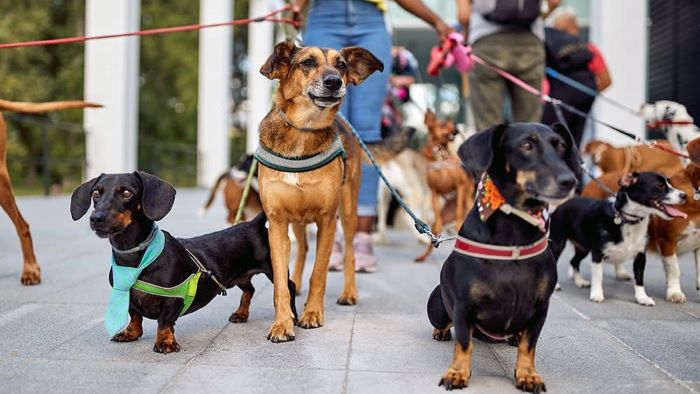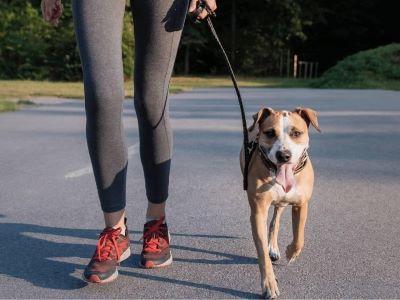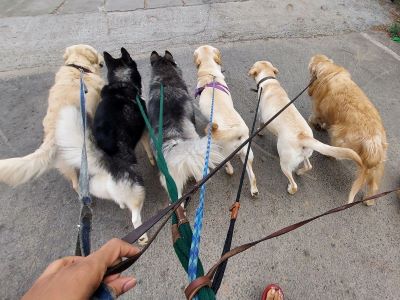Walking dogs can be a fun and rewarding job for people who love animals. But did you know, that dog walking requires dedication, responsibility, and the ability to handle multiple animals simultaneously? So how many dogs can a dog walker walk realistically?
How many dogs a walker can handle depends on several variables. Those variables can include size, age, energy levels, and temperaments. Additionally, the walker’s own experience and physical capabilities are important considerations as well. While some expert walkers may be able to handle five or more dogs, beginners are better off starting with one or two.
This article provides tips and recommendations to help dog walkers, both new and experienced, determine a logical number of dogs to walk together. The key factors of keeping them under control are ensuring safety and providing adequate care and attention to each dog.

Factors That Determine the Number of Dogs
A dog breeder has to control and make the dogs obey his/her commands. But not every breed diligently listens to commands and obeys a person who is not their owner. Dog breeders have to take account of the factors that affect their dog management skills and accordingly plan their further actions.
Several key factors determine “How Many Dogs Can a Dog Walker Walk?” during one walk. Some of them are here as follows[1]:
Size of the Dogs:

Now when it comes to dogs size matters. Toy breeds like Chihuahuas and Yorkshire Terriers typically have less stamina for long walks and are easily controlled with lashes as they are small in size. This allows an experienced walker to potentially handle 5-6 toy breed dogs at once.
Meanwhile, large breed dogs like Great Danes and Saint Bernards require much more physical effort and strength from the walker. Even just 2-3 large dogs could be a handful. The dogs’ sizes and strengths need to be balanced.
Ages and Energy Levels:
Age and energy levels go hand in hand. Puppies and younger dogs tend to have abundant energy and are excited by all excited by the sights, sounds and smells on a walk. They can be more difficult to contain in a comfortable walking space.
While senior dogs move slower and make fewer attempts to run or stray. A good mix of ages and energy levels makes for an easier walk. Hyperactive puppies paired together may become a bit difficult to handle for the walker.
Temperaments:
Every dog has a unique personality and temperament. Which is why it greatly impacts how they behave on a group walk. Dogs with more relaxed temperaments tend to stay near the walker and politely greet other dogs.
Aggressive dogs are more likely to bark and pull on leashes, hence requiring constant monitoring. Walkers must access temperaments and create compatible dog groupings to avoid any nuisance.
Every dog has a unique personality and temperament which impacts how they behave on walks. Walkers need to account for dogs with special needs, such as learning how to walk a blind dog if they have vision issues.
Experience Level of the Walker:

A walker’s skill level is just as important as their management skills. Beginners need time to practice techniques like voice commands and maintaining a steady pace before adding more dogs.
Even experts started small to gain real-world experience. Having the confidence to handle issues like leash messes comes only with time. Attempting too many dogs at once can be bad early on.
Physical Capability:
Physical capability is essential for handling multiple leashes while also picking up dog waste and preventing staying. Strength, coordination and stamina allow walkers to go the distance with dogs of many sizes, energies and temperaments.
Knowing personal limits helps determine how many dogs can be managed safely. Overstressing the walker is not a good sign as your dog can eventually become aggressive because of not giving proper care.
Recommendations for Beginners

The dog walkers who are just starting their journey, are recommended to begin with one or two dogs at max. This allows the walker to get comfortable with the basics before actually taking on a larger group of dogs.
Avoid taking jobs that ask you to handle aggressive dogs, because as a beginner you’re not prepared to calm the dogs or stop them from attacking each other. Here are some recommendations that will help dog walkers determine “How Many Dogs Can a Dog Walker Walk?” when starting their journey as beginners:
- #1 – Get to know the dogs first. Walk each dog individually to understand their personality and walking habits. This allows you to determine if they would walk well together.
- #2 – Only pair dogs of similar size and temperament as you begin. For example, walking a high-energy Labrador with a relaxed senior poodle could pose challenges for a new walker. Start with dogs that seem compatible.
- #3 – Practice voice commands. Use clear, simple commands like “wait”, “heel”, and “let’s go” during solo walks. Dogs need training to respond to commands in exciting group situations.
- #4 – Try different types of equipment. Experiment with different collars, harnesses and multifunction leashes to find what gives you the most control and the dogs the most comfort.
- #5 – Start with short walks close to home. Keep initial group walks low-stress by staying in quiet areas you’re familiar with. You want to minimize unpredictable distractions as you learn.
- #6 – Reward and reinforce for good behaviour. Use treats and praise to motivate the dogs to focus on you and walk politely together. This the walker can make dog groups for well-behaved group walks.
Beginners should invest in high-quality gear designed for dog walking like the best gadgets for dog walkers - ergonomic leashes, foldable bowls, waste pickup tools. This equipment will make handling those first few pups easier.
Tips from Experienced Walkers

Experienced dog walkers utilize various techniques to have control over the dogs. The key is to maintain your cool and harmony when handling large packs of diverse dogs. One thing that most people won’t relate to, is a dog walker needs to befriend your pet to have it listen to him.
Experience comes from the heart, and if you’re skilful enough to handle even 2 dogs at a time, you’ll go a long way in this career opportunity. Some tips from the experienced walkers are here as follows:
- Try short vocal commands like “stay” and “leave it” that are clearer for dogs to understand. Whistles and hand signals are also useful to have its attention on you. Training your voice control and commanding is essential for minimizing distractions.
- High-quality adjustable leashes, waist packs, collapsible bowls and waste bags allow walkers to handle all the leash-tugging, water splashing, and poop scooping that comes with all big dog groups.
- Experienced walkers are honest with themselves about their physical limitations. Attempting to control five 70-pound dogs could result in injuries on both sides. But three 30-pound may be a sensible option. You should know your sweet spot between strength and stamina.
- Balancing the group by age, size and temperament prevents problems. High-energy adolescent dogs paired only with slower senior dogs struggle to sync paces. Small dogs can get overwhelmed by the large ones in the group. Diversity creates balance.
- Reading the body language of the dogs will help you spot tensions between them before the real aggression occurs i.e. stiffening, staring, growling. Being able to interrupt prevents fights that could happen as new dogs join.
- If a new dog is repeatedly disruptive to the group’s vibe, responsible walkers make adjustments to avoid ongoing issues. This may mean trying the dog on solo walks instead.
- Ending the walk positively is key. As soon as whining, reluctance, or mild spats occur, it’s time to wrap up and go home before the experience gets ruined.
Ensuring Safety and Proper Care
Safety and Precautions come first when it comes to taking responsibility as a Dog Walker. Giving them proper care, and training them to have safer strolls with the other dogs, is also a part of their job description.
A dog walker should never lose sight of his dogs and if their leashes get tangled, he should be prompt enough to manage without letting it slip through. Some key factors that determine the role of a Dog Walker are as follows:
Maintaining Control of the Pack

Keeping control of a walking dog group is essential for safety. Use clear voice commands regularly so dogs walk calmly together, and not drag the walker with them getting their leashes tangled. Too many dogs pulling can result in injuries. Walkers need to use their best judgement on what number of dogs exceeds their physical control capabilities.
Preventing Confrontations Between Dogs
A dog walker should notice rising tensions between dogs quickly through subtle body language cues like staring, stiffening, and growling. Intervene proactively if needed by creating more space around aggressive dogs. For instance, have them walk separately front and back. Stopping conflicts before they escalate maintains harmony.
Ensuring Proper Hydration
Dog walkers should bring water and collapsible bowls with them to provide drinks when dogs get thirsty. Recognize signs of overheating like heavy panting and red gums. He/she should allow adequate water breaks to prevent heat exhaustion, especially on hot days. You should not rush the pace in a way that could harm dogs not acclimated to long distances.
Providing Individual Attention
Give each dog periodic attention through treats, petting, and praise. This makes sure that every dog feels recognized in the group. If any dog shows excessive stress, they may benefit from solo walks next time when the focus is all on them.
Prioritizing Health and Happiness
Dog walkers should emphasise safety, comfort, and care. If those needs are not being met, make adjustments. For instance, reduce the number of dogs, go slower, and provide more rest. Do not prioritize distance, speed or numbers above the dogs’ well-being.
FAQs
How many dogs can a dog walker walk?
There are a few key factors – the dog’s size, age, energy levels, and personalities all play a role. Plus the experience and physical ability of the walker matter too. You want a balanced group that’s under control.
If someone is just starting out walking dogs, how many should they begin with?
Best for beginners to start with one or two dogs, max. That gives them time to get comfortable with the basics before having a whole pack to wrangle! Starting small helps build confidence.
What’s a good way for a new walker to practise controlling multiple pooches?
Solo walking each dog first helps you understand their needs. Stick to pairing dogs of similar size and temperament, and do short group walks close to home so there’s less unexpected craziness. That sets you up for success!
What tricks do expert walkers use to handle big groups?
Voice commands and whistles are key for getting their attention quickly. Good equipment like adjustable leashes helps too. And knowing their physical limits – don’t overdo it! Understanding dog behaviour is important for a harmonious, happy pack. Ending on a positive note keeps their dogs eager for next time.
How can someone make sure every pup is safe and cared for on a group walk?
Keep control of the pack, head off any disputes between dogs before they escalate, provide water and rest as needed, give each dog individual attention periodically, and call it quits if any pooch seems overly stressed or tuckered out.
Conclusion
Determining the ideal number of dogs for a walker comes down to the dogs themselves and the walker’s abilities. The dog’s size, age, energy levels, and personality all matter. The walker must also consider their physical capabilities and experience level. The goal is a balanced group where the walker can maintain control and give quality care.
While some pros may handle five or more dogs at once, beginners should start with one or two dogs and work up gradually. While many readers would ask “How Many Dogs Can a Dog Walker Walk?“, there is no perfect number. Everything depends on the unique walker and pack of dogs.
Most importantly, safety and happiness for each dog should be the top priority, not the quantity. With practice and patience, walkers can confidently handle more dogs. But it’s best to start small, get to know the dogs and focus on their individual needs. That’s the recipe for enjoyable walks!
Determining the ideal number of dogs comes down to the individual walker's skills and the dogs' needs. For those interested in turning dog walking into a business, key next steps would be researching how to start a dog walking business in your area.
References:
- Professional Dog Walkers’ Guidelines – RSPCA



